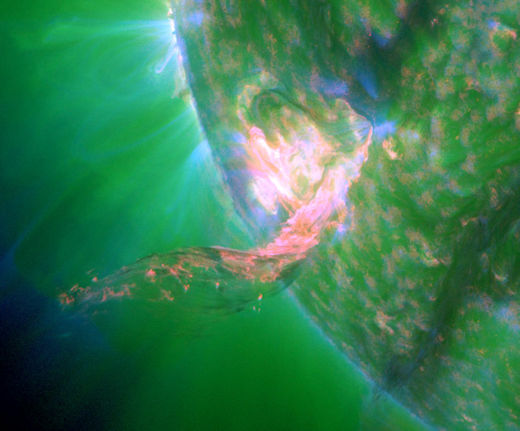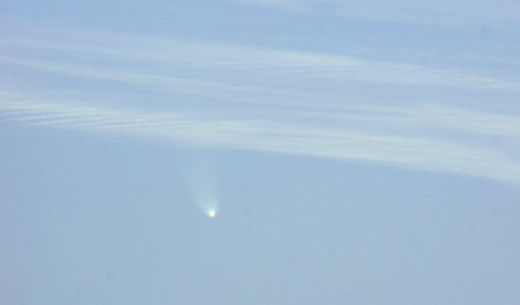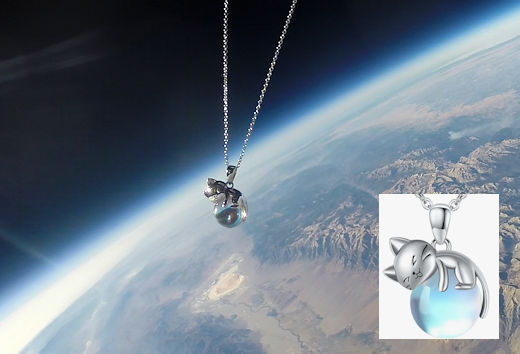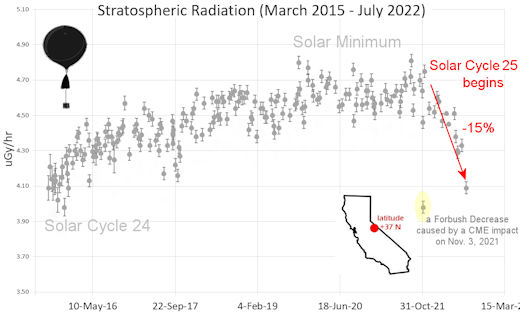This is an AI Free Zone! Text created by Large Language Models is spreading rapidly across the Internet. It's well-written, artificial, frequently inaccurate. If you find a mistake on Spaceweather.com, rest assured it was made by a real human being. | | |
POSSIBLE EARTH-DIRECTED EXPLOSION: Surprising forecasters, who thought sunspot AR3835 was too stable to explode, sunspot AR3835 exploded on Sept. 22nd (2139 UTC). The M3.4-class flare hurled a massive plume of plasma into space:

Debris from the blast entrained even more plasma on its way out of the sun's atmosphere, forming a partial halo CME. The bulk of the CME will miss Earth, but its flank will deliver a glancing blow to our planet on Sept. 25th, according to a NASA model.
At this time of year, even a glancing blow from a CME can cause a geomagnetic storm. Why? Because during weeks around equinoxes, Earth's magnetic field is unusually well connected to the sun's. It's called the "Russell-McPherron effect." The incoming CME could therefore cause a G1-class geomagnetic storm when it reaches Earth. Aurora alerts: SMS Text
Realtime Space Weather Photo Gallery
Free: Spaceweather.com Newsletter
APPROACHING COMET SEEN FROM THE ISS: Comet Tsuchinshan-ATLAS (C/2023 A3) is approaching Earth and brightening rapidly. "So far Comet Tsuchinshan-ATLAS looks like a fuzzy star to the naked eye, but with a 200mm, f2 lens at 1/8s exposure you can really start to see it!' reports NASA astronaut Matthew Dominick, who photographed the comet from the International Space Station on Sept. 19th:
Dominick's time lapse movie shows the comet rising above Earth's airglow layer along with at least 3 satellites. "This comet is going to make for some really cool images as it gets closer to the sun," he says.
Indeed, the comet will fly by the sun on Sept. 27th, receiving a dose of solar heating as it approaches Earth for a close encounter on Oct. 12th. As seen from our planet, the sun-warmed comet's brightness could reach negative magnitudes during the second week of October.
"Negative magnitude" means Comet Tsuchinshan-ATLAS would be visible in broad daylight, especially on Oct. 9th when light from the nearby sun will be forward scattered by comet dust, amplifying the comet's brightness. If the most optimistic predictions come true, it could look like Comet McNaught in 2007:

Comet McNaught photographed in daylight by Thorsten Boeckel on Jan. 13, 2007. [gallery]
Forward scattering also boosted the brightness of Comet McNaught, making it visible in daylight as a magnitude -5.5 object. Thousands of observers alerted by Spaceweather.com saw the comet in the noontime sky. Could it happen again? Stay tuned!
more images: from Mariano Ribas of Buenos Aires, Argentina; from Chaim Scowcroft of Sandy Beach Oahu, Hawaii
Realtime Comet Photo Gallery
Free: Spaceweather.com Newsletter
STERLING SILVER MOONCAT: This cat has experienced a severe geomagnetic storm. A CME hit Earth's magnetic field during on Sept. 16th. The students of Earth to Sky Calculus quickly launched a cosmic ray balloon into the resulting storm, with the Sterling Silver Mooncat hitching a ride:

You can have it for $199.95. Curled around a genuine blue moonstonethe sterling silver cat floated through the stratosphere for almost 3 hours during the storm, gathering radiation data for the students' monitoring program. The Mooncat comes with a greeting card showing the pendant in flight and explaining the radiation experiment.
The students of Earth to Sky Calculus are selling space jewelry to support their cosmic ray ballooning program. Don't wait for Christmas--get yours now!
Far Out Gifts: Earth to Sky Store
All sales support hands-on STEM education
Realtime Aurora Photo Gallery
Free: Spaceweather.com Newsletter
Realtime Noctilucent Cloud Photo Gallery
Free: Spaceweather.com Newsletter
Every night, a network of
NASA all-sky cameras scans the skies above the United States for meteoritic fireballs. Automated software maintained by NASA's Meteoroid Environment Office calculates their orbits, velocity, penetration depth in Earth's atmosphere and many other characteristics. Daily results are presented here on Spaceweather.com.
On Sep 22, 2024, the network reported 10 fireballs.
(10 sporadics)

In this diagram of the inner solar system, all of the fireball orbits intersect at a single point--Earth. The orbits are color-coded by velocity, from slow (red) to fast (blue). [Larger image] [movies]
Potentially Hazardous Asteroids (
PHAs) are space rocks larger than approximately 100m that can come closer to Earth than 0.05 AU. None of the known PHAs is on a collision course with our planet, although astronomers are finding
new ones all the time.
On September 23, 2024 there were 2349 potentially hazardous asteroids.
 |
Recent & Upcoming Earth-asteroid encounters: | Asteroid | Date(UT) | Miss Distance | Velocity (km/s) | Diameter (m) |
| 2024 RZ13 | 2024-Sep-18 | 16.6 LD | 8.6 | 16 |
| 2013 FW13 | 2024-Sep-18 | 8.5 LD | 15.6 | 162 |
| 2024 RJ13 | 2024-Sep-18 | 10.7 LD | 13.1 | 21 |
| 2024 RH8 | 2024-Sep-18 | 8.4 LD | 17.5 | 46 |
| 2022 SW3 | 2024-Sep-19 | 6.6 LD | 9.2 | 37 |
| 2015 SH | 2024-Sep-19 | 11.6 LD | 5.9 | 9 |
| 2024 RJ1 | 2024-Sep-20 | 15.4 LD | 8.9 | 42 |
| 2024 RD15 | 2024-Sep-20 | 18.7 LD | 8.2 | 16 |
| 2024 RH14 | 2024-Sep-20 | 7.2 LD | 11.7 | 21 |
| 2024 RB10 | 2024-Sep-20 | 19 LD | 12.8 | 73 |
| 2024 QV5 | 2024-Sep-20 | 13.9 LD | 10.6 | 35 |
| 2024 RB22 | 2024-Sep-20 | 8.6 LD | 2.8 | 44 |
| 2023 RX1 | 2024-Sep-20 | 10.1 LD | 1.1 | 3 |
| 2018 VG | 2024-Sep-20 | 13.4 LD | 7.3 | 12 |
| 2024 RY15 | 2024-Sep-21 | 2.3 LD | 13.6 | 28 |
| 2024 SD | 2024-Sep-21 | 0.3 LD | 13.9 | 7 |
| 2024 RZ21 | 2024-Sep-21 | 11.7 LD | 18 | 35 |
| 2020 GE | 2024-Sep-24 | 1.7 LD | 2.2 | 8 |
| 2024 RO11 | 2024-Sep-24 | 19.2 LD | 19.1 | 39 |
| 2024 RK7 | 2024-Sep-25 | 17.8 LD | 6.3 | 33 |
| 2024 RW25 | 2024-Sep-27 | 16.1 LD | 9.8 | 26 |
| 2024 RP15 | 2024-Sep-27 | 17.5 LD | 9.9 | 30 |
| 2011 ST12 | 2024-Sep-27 | 17.6 LD | 7.4 | 19 |
| 2024 SE | 2024-Sep-28 | 7.6 LD | 10.9 | 44 |
| 2024 SC | 2024-Sep-30 | 4.2 LD | 17.7 | 95 |
| 2024 RN15 | 2024-Oct-01 | 8.4 LD | 7.2 | 29 |
| 2024 RO2 | 2024-Oct-02 | 4.2 LD | 9.2 | 36 |
| 2024 RJ16 | 2024-Oct-02 | 18.2 LD | 6.9 | 24 |
| 2024 RJ32 | 2024-Oct-05 | 7.7 LD | 6.6 | 45 |
| 2023 GM1 | 2024-Oct-05 | 15.4 LD | 5.2 | 13 |
| 2014 VA | 2024-Oct-05 | 18.1 LD | 6.3 | 46 |
| 2022 SU21 | 2024-Oct-06 | 17.5 LD | 21.1 | 45 |
| 671076 | 2024-Oct-07 | 12.8 LD | 8.6 | 120 |
| 2016 JG38 | 2024-Oct-08 | 13.2 LD | 12 | 56 |
| 2018 QE | 2024-Oct-09 | 1.7 LD | 4.4 | 10 |
| 363027 | 2024-Oct-12 | 9.3 LD | 16.6 | 419 |
| 2020 GE1 | 2024-Oct-12 | 20.1 LD | 4.3 | 14 |
| 2022 UX1 | 2024-Oct-12 | 19.9 LD | 9.9 | 9 |
| 2008 UU95 | 2024-Oct-12 | 13.5 LD | 15.6 | 66 |
| 2021 TK11 | 2024-Oct-14 | 8 LD | 10.6 | 7 |
| 2022 TB41 | 2024-Oct-15 | 10 LD | 6 | 4 |
| 2019 UH14 | 2024-Oct-17 | 8.3 LD | 10.4 | 62 |
| 2015 HM1 | 2024-Oct-24 | 14.4 LD | 10.9 | 32 |
| 363305 | 2024-Oct-24 | 11.8 LD | 4.9 | 186 |
| 2021 UE2 | 2024-Oct-24 | 13.6 LD | 7.1 | 40 |
| 2023 TG14 | 2024-Oct-24 | 6.6 LD | 6.9 | 24 |
| 2007 UT3 | 2024-Oct-26 | 17.7 LD | 10.4 | 23 |
| 2020 WG | 2024-Oct-28 | 8.7 LD | 9.4 | 160 |
| 2021 CV1 | 2024-Oct-30 | 14.4 LD | 23.6 | 38 |
| 2023 KX3 | 2024-Oct-31 | 18.8 LD | 2.4 | 25 |
| 2022 UD21 | 2024-Oct-31 | 11.4 LD | 11.8 | 27 |
| 2016 VA | 2024-Nov-01 | 1.5 LD | 21.2 | 11 |
| 2023 VS | 2024-Nov-04 | 15.2 LD | 4.3 | 4 |
| 2022 JM | 2024-Nov-06 | 19.7 LD | 6.2 | 6 |
| 2019 WB7 | 2024-Nov-11 | 17.3 LD | 5.7 | 47 |
| 2020 UL3 | 2024-Nov-12 | 4.1 LD | 10.5 | 81 |
| 2020 AB2 | 2024-Nov-13 | 18.9 LD | 7.2 | 14 |
| 2019 VU5 | 2024-Nov-14 | 12 LD | 23.3 | 46 |
| 2019 VL5 | 2024-Nov-14 | 9.6 LD | 8.5 | 24 |
| 2023 WK3 | 2024-Nov-18 | 16.1 LD | 14.5 | 272 |
| 2012 KO11 | 2024-Nov-20 | 6.2 LD | 9.4 | 43 |
| 2020 VX4 | 2024-Nov-20 | 10.5 LD | 10.5 | 11 |
Notes: LD means "Lunar Distance." 1 LD = 384,401 km, the distance between Earth and the Moon. 1 LD also equals 0.00256 AU. | | Cosmic Rays in the Atmosphere |
SPACE WEATHER BALLOON DATA: Almost once a week, Spaceweather.com and the students of Earth to Sky Calculus fly space weather balloons to the stratosphere over California. These balloons are equipped with sensors that detect secondary cosmic rays, a form of radiation from space that can penetrate all the way down to Earth's surface. Our monitoring program has been underway without interruption for 7 years, resulting in a unique dataset of in situ atmospheric measurements.
Latest results (July 2022): Atmospheric radiation is decreasing in 2022. Our latest measurements in July 2022 registered a 6-year low:

What's going on? Ironically, the radiation drop is caused by increasing solar activity. Solar Cycle 25 has roared to life faster than forecasters expected. The sun's strengthening and increasingly tangled magnetic field repels cosmic rays from deep space. In addition, solar coronal mass ejections (CMEs) sweep aside cosmic rays, causing sharp reductions called "Forbush Decreases." The two effects blend together to bring daily radiation levels down.
.Who cares? Cosmic rays are a surprisingly "down to Earth" form of space weather. They can alter the chemistry of the atmosphere, trigger lightning, and penetrate commercial airplanes. According to a study from the Harvard T.H. Chan school of public health, crews of aircraft have higher rates of cancer than the general population. The researchers listed cosmic rays, irregular sleep habits, and chemical contaminants as leading risk factors. A number of controversial studies (#1, #2, #3, #4) go even further, linking cosmic rays with cardiac arrhythmias and sudden cardiac death.
Technical notes: The radiation sensors onboard our helium balloons detect X-rays and gamma-rays in the energy range 10 keV to 20 MeV. These energies span the range of medical X-ray machines and airport security scanners.
Data points in the graph labeled "Stratospheric Radiation" correspond to the peak of the Regener-Pfotzer maximum, which lies about 67,000 feet above central California. When cosmic rays crash into Earth's atmosphere, they produce a spray of secondary particles that is most intense at the entrance to the stratosphere. Physicists Eric Regener and Georg Pfotzer discovered the maximum using balloons in the 1930s and it is what we are measuring today.
| | The official U.S. government space weather bureau |
| | The first place to look for information about sundogs, pillars, rainbows and related phenomena. |
| | Researchers call it a "Hubble for the sun." SDO is the most advanced solar observatory ever. |
| | 3D views of the sun from NASA's Solar and Terrestrial Relations Observatory |
| | Realtime and archival images of the Sun from SOHO. |
| | information about sunspots based on the latest NOAA/USAF Active Region Summary |
| | current counts of failed and deployed Starlink satellites from Jonathan's Space Page. See also, all satellite statistics. |
| | Authoritative predictions of space junk and satellite re-entries |
| | from the NOAA Space Environment Center |
| | fun to read, but should be taken with a grain of salt! Forecasts looking ahead more than a few days are often wrong. |
| | from the NOAA Space Environment Center |
| | the underlying science of space weather |
 | Got a chipped or cracked windshield that prevents you from seeing space weather events while driving? Get windshield replacement from SR Windows & Glass with free mobile auto glass service anywhere in the Phoenix area. |
 | BestCSGOGambling is the best site for everything related to CSGO gambling on the web |
| | These links help Spaceweather.com stay online. Thank you to our supporters! |
| | | | | | |

